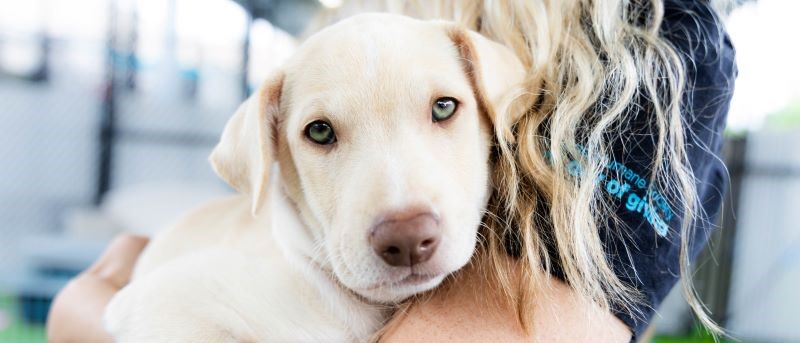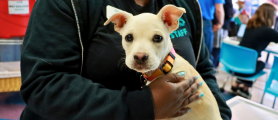The Good Behavior Guidebook
The ultimate guide to training dogs, cats, guinea pigs, hamsters, rabbits and everything in between.

It’s Common
Solutions to common pet behavior problems

Great Crates
Make your pet's crate or carrier less stressful with treats, toys and other good stuff.
When people adopt shelter pets and subsequently return them due to “adopter’s remorse,” bad behavior is often the culprit. But in many cases, it’s not too late to reverse course. Lindsey Lieberman, behavior and training coordinator at San Diego Humane Society’s Oceanside Campus, says many undesirable behaviors can be curbed with patience, positive reinforcement—and a little help from SDHS experts. “We run into a lot of people who feel that because they’d grown up with pets and had pets their whole adult lives, they know how to work with them behaviorally,” she says. “That’s like me saying because I grew up around cars and have been driving my whole adult life, I can fix my engine.” Here, Lieberman outlines some DIY behavior fixes, and some signs that it’s time to consult a professional.
Keep It Positive
Rewarding an animal for good behavior, or positive reinforcement, works almost universally. It comes in handy for impulse control issues like jumping, mouthing and excessive barking—but only if you notice when your pet does the right thing. “We spend a huge amount of time ignoring our pets when they make choices we like, because those are the behaviors we expect,” Lieberman says. Animals learn to make the association quickly if their bad behavior equals interaction, for example if we respond to a dog’s barking for attention by trying to reassure them. Interrupt or ignore bad behavior, then flip the script and give them attention when they make better choices. Rewards work for remedial socialization, too. Pair the sight of another dog (at a safe distance) with something valuable, like a piece of cheese, and eventually they’ll associate other dogs with good things.
Cozy Crates
Crate training can be the solution to a host of canine conundrums, including destructive behavior, escape artistry and housetraining hang-ups. It’s an excellent management tool, and when used correctly it can reduce many of the problems that lead to people rehoming their dogs. But it must be done right. “Some people just get a crate and say, ‘I’m crating the dog now,’” Lieberman says. “If you have a dog who’s never been in a crate and you put him in a crate for eight hours, it’s not going to go well.” Do a slow and appropriate introduction so the dog learns to see their crate as a comfy hangout where good things happen.
Practical Products
Occasionally an owner returns their dog to SDHS because they wouldn’t walk appropriately on a leash. If it feels more like your dog is walking you, try a no-pull harness. “It’s not resolving the issue, but it will help you both enjoy walks a lot more,” Lieberman says. Pet stores also carry cat claw covers and double-stick tape to curb scratching, though she notes that while one cat may shy away from the tape, another may come up and lick it. “You have to find the right thing for that specific animal.”
Go Pro
For some issues, it’s best to consult a professional, whether that means a trainer, a vet or an expert on the other end of SDHS’s free Behavior Helpline.
Make a vet appointment if your cat is having litter box issues. When a housetrained cat starts peeing outside their litter box, it’s often not a behavior issue but a urinary tract infection.
Consult a pro if your dog’s resource guarding goes from annoying to dangerous. It’s possible to modify resource guarding at home if you have the right tools, but sometimes advice in books or online is contradictory, inappropriate or unsafe, Lieberman says. Reactivity and not getting along with other pets are also issues best left to the pros, but owners need to pitch in. “We can teach the animal a few things, but you’re the one living with them day to day; you’re the one who has to continue the work, to practice what we preach.”
Social Petworking
Socializing pets early can prevent many behavior problems down the line, but older animals can benefit from a social refresher too
Horsing Around

With the right training and socialization, horses can become part of the family too. Like most other animals, horses respond well to positive reinforcement. Find your horse’s specific motivation—carrots and patience go a long way toward improving a horse’s behavior and helping you bond with your new equine pal. Clicker training works, too, though getting your technique down may require some advice from the pros. Attentive grooming routines before or after a training session will also help you establish trust with your horse.
The number-one area where pets can use improvement, according to San Diego Humane Society trainers, is socialization: getting comfortable around unfamiliar animals, people and situations. Ideally, this begins when they’re very young and apt to soak up new information.
Socializing animals is like vaccinating them against future problems, says Shannon Feeney, a behavior and training coordinator at SDHS. Baby animals build a diverse database rich in positive experiences that they can draw from throughout life. The goal is to not only expose them to things they’ll face as adults, but teach them how to respond to new experiences in general.
“Socialization is a preventive measure for any behavior we would lump into the category of ‘behavior concerns,’” Feeney says. “When animals are reactive, often that response is out of fear, stress or anxiety that erupts when that animal is faced with something that’s not in their database.”
People tend to measure socialization quantitatively—for example, getting their dog used to others by exposing them to a lot of people and animals at once—but for animals of any age it’s a qualitative approach that counts. Don’t just show up at the dog park hoping for the best; introduce your pet to novel experiences in a controlled way. For instance, playgroups and behavior classes at SDHS (cat classes will be offered this spring) are attended by a trainer who can translate their body language “conversations.”
Not every animal receives a strong foundation though. Dogs and cats between 6 and 18 months are commonly relinquished to shelters due to behavior concerns. “A lack of exposure to things in early puppyhood or kittenhood can be just as damaging as neglect,” Feeney says.
At that point, SDHS trainers step in, armed with hot dogs, cream cheese and even a refreshing leashed run. “Animals are working hard for a salary just like we are,” she says. “You have to identify what motivates an animal’s behaviors, and you have to do a good job of providing reinforcement.”
Then it’s up to future adopters to keep up the good work (and treats!). Consult a trainer or behavior expert about specific concerns. Learn about animal development and how to teach them in a positive way. Seek playgroups and manners classes taught by instructors who know that you can teach old dogs new tricks.
Your Handy Guide to Social Petworking
Cats
Kitten
- Get your kitten comfortable with being touched, including on their paws, ears and tail. Treats during and afterward go a long way.
- Introduce them to common background noises (at a low volume) like vacuums, TVs and crying babies. You might be surprised how many specialized videos YouTube has for just this purpose.
- Try different kinds of litter boxes, kitty litter and canned food.
- Start exposing them to crates and cars around 4 weeks and, about a week later, the dreaded nail clippers.
- Teach your kitten to interact with a variety of people. Have new people reward them with a treat or wand toy when they approach unprompted.
- A handy checklist is available at sdhumane.org/resources.
Adult
- Be patient and give your cat a safe place to hide if they get overwhelmed.
- Ease your cat into being handled. Start by petting their “safe” areas, then move on to other spots that have previously drawn a reaction, such as their belly, paws or tail, and pick them up. Follow up with a treat. If they bite or scratch, calmly end the session.
- After you’ve earned your cat’s trust, introduce them to other people. Don’t force it; let the cat come to them.
- Always reinforce good behavior.
Dogs
Puppy
- Get your puppy comfortable interacting with and being handled by different people.
- Introduce common background noises (at a low volume).
- Nip resource guarding in the bud by approaching your puppy while they’re eating and then dropping a treat in their bowl, or by picking the bowl up, adding a treat and setting it back down.
- Leave your puppy alone for some time every day with a Kong, their favorite toy or a food puzzle. This will help them feel comfortable with being alone and prevent separation anxiety in the future.
- Keep slowly and carefully introducing your dog to other people and pets. Expose them to other dogs from a safe distance and for short periods. Reward your dog with treats and praise when they don’t react fearfully or aggressively.
- Don’t be afraid to consult a behavior specialist or professional trainer about specific concerns.
Rabbits
- Let your bunny come to you at their own pace. If you approach them, do so slowly and from the side—bunnies scare easily.
- Interact with your rabbit on their level, even if that means lying on the floor. Most rabbits don't like to be picked up, but they may sit on or by you.
- Offer treats so they associate interaction with something positive.
Rodents
- Be patient and give your new pet time to adjust to your home and your family.
- Don’t approach them from overhead, as a predator would. Get down to their level, whether you’re on the floor or they’re on a table.
- Use a neutral object to pick them up, and let them work their way into your hands.
- Practice for a few minutes every day or two.
Birds
- Most birds are social creatures. Interact with your bird as if they’re part of the family (or you’re part of the flock). Don’t be surprised if they pick a favorite person.
- Keep your movements slow and steady and watch for positive signs like singing, talking or whistling. Work up to gently stroking the back of your bird’s head and their back. Slow blinking until they do it back can help build trust.
- Communicate with your bird as much as possible. Talk softly to them and let them mimic the sounds.
- Reward them with a few seeds or another yummy treat.
Reptiles
- Keep your expectations in check. Reptiles aren’t as cuddly as other pets, and some don’t like being handled at all.
- Give treats after handling your lizard, turtle or snake. Positive reinforcement is never a bad thing.
- Start slowly with lizards by placing your hand into their habitat to test their reaction. If they continue to dart away after several attempts, accept that they may not ever like being handled.
- Some turtles and tortoises can come to enjoy being hand fed and even having their necks rubbed, but not so much being picked up.
- Let your cold-blooded pet rest next to your warm body once they're comfortable with you to promote bonding.
Sources: SDHS, Animal Humane Society, vetstreet.com, catster.com, WikiHow, All About Animals Veterinary Services, exoticpetvet.net, Pet Age, Petco
How to Score a Pet-Friendly Pad (Even With a Pit Bull)

Start early and be patient.
Give yourself plenty of time to check out rentals and make sure they would be a good fit for you and Fido.
Pet restrictions are a common obstacle for dog owners who rent, especially those with bigger breeds. Some apartments, condos and houses listed as “dog friendly” seem like a good fit until the landlord mentions that the policy applies only to pooches under 20 pounds. Though it may feel like you’re hunting for a needle in a haystack, truly pet-friendly homes can be found throughout the city. Here are a few tips to help with your search.
Start early and be patient. Give yourself plenty of time to check out rentals to make sure they would be a good fit.
Beware of breed restrictions. Bully breeds get a bad rap and can be a non-starter at some properties. Look for listings that specifically state “no breed restrictions,” or inquire ahead of the initial showing.
Provide references from past landlords, vets, trainers or anyone who can speak to your dog’s overall demeanor. Some pet owners go so far as to submit a “doggie résumé” to show potential landlords proof that their pup has been well-behaved, clean and quiet, or has graduated from training classes.
Be prepared to pay. Many properties that allow pets request an inflated security deposit to cover potential damage, charge higher monthly rent and require a separate pet application (and fee). And for properties with stated breed or weight limits, offering a little extra cash on the deposit or rent might persuade owners to make a reasonable exception.
Individual owners can be more amenable to pet policy exceptions than property management companies. Highlight your dog’s training and offer to set up a meet and greet in hopes of winning them over.
Carry a renter’s insurance policy that covers pets and disclose that you have it the first chance you get.
Finally, if an owner makes a pet policy exemption for your dog, make sure to get it in writing.
These websites can be helpful when searching for pet-friendly housing:
apartmentlist.com
apartmentguide.com
sandiego.craigslist.org
hotpads.com
humanesociety.org
move.com
mynewplace.com
peoplewithpets.com
rent.com
tenantslegalcenter.com
trulia.com
zillow.com
Teacher's Pet

San Diego Humane Society offers several specialty training classes and socialization groups to help your dog or cat learn the ins and outs of good behavior.
Kitten Kindergarten
Impressionable kitties 7–13 weeks old get valuable socialization time with new feline friends, carrier and vet visit practice, and clicker training basics.
Puppy Play Group
Pups under 16 weeks work on their social skills in a safe, supervised environment.
Marvelous Manners
A primer for pups 4 months and older on loose-leash walking, basic commands and greeting without jumping.
Superb Skills
A continuation of Marvelous Manners; dogs build on what they’ve learned and add new behaviors to their repertoire.
Polite Pooches
Dogs 4 months and older learn how to behave appropriately on leash—and not pull you down the street.
Shy Dog Class
Timid dogs build trust and confidence through positive reinforcement training.
K9 Nose Work
Beginner, intermediate and advanced courses teach your pet to sniff out hidden items in containers, in vehicles and even underground.
Rapid Recall
Motivate your dog to come when called, pay attention and return quickly.
Canine Good Citizen
Fine tune your dog's cue consistency in everyday public situations. Polite greetings, ignoring distractions, brief separations and more..
Class Pass
Learn more about and register for SDHS training classes at sdhumane.org/programs/behavior-and-training.
What Is Positive Reinforcement Training?
Understand the basics of this humane method and find a dog trainer using it.

When looking for a dog trainer...
It’s a good sign if they say they will determine what best motivates your dog to find the right reinforcement.
Choosing the right dog trainer is no easy task. It’s made even more confusing by the fact that, although a trainer can earn certain certifications, dog training is by and large an unlicensed and unregulated field. “Anyone can call themselves a dog trainer, regardless of whether they have any education or formal training in animal behavior,” says Amanda Kowalski, director of San Diego Humane Society’s Behavior Center.
What to look for
Kowalski recommends finding a trainer who uses “reward-based,” “positive reinforcement,” “force-free” or “humane training” methods. All those terms mean the same thing: The trainer rewards the dog to encourage desired behaviors and withholds rewards to discourage undesirable ones. “Whether it’s food, petting, play or access to something they want, you’re giving the dog something that will motivate them and increase the chances they’ll repeat the desired behavior,” she says. Food often works best because it’s an instant reward dogs enjoy.
What to avoid
Steer clear of trainers who rely on shock collars, prong collars, leash corrections, taking an “alpha” role or other aversive techniques. “Sometimes they’ll say they have a ‘balanced method,’ meaning they use aversive techniques but also food,” Kowalski says. “People don’t realize how much risk is involved when using those methods. You could cause your dog to experience more fear and develop more serious behavior problems.”
Ask these questions before handing over your precious pup:
Q. What kind of training equipment do you use?
You want them to recommend a no-pull or back-clip harness, a Martingale or buckle collar, or a 6-to-8-foot flat leash.
Q. What do you do when a dog responds how you want?
They should use a fun activity, toys or food—something the dog enjoys. It’s also a good sign if they say they will determine what best motivates the dog to find the right reinforcement.
Q. How would you know if my dog is stressed during training?
Experienced trainers can interpret canine communication in the form of licking, paw lifting, panting, sniffing the ground randomly, turning their head away or moving away from the trainer.
Q. Do you guarantee your training results?
Reward-based trainers generally do not. There are too many variables involved. Behavior is fluid, and often responses are affected by the environment. If fireworks are going off, for example, the dog might be too overwhelmed to respond based on how he’s been trained.
Look for these certifications:
Certified Professional Dog Trainer-Knowledge Assessed (CPDT-KA)
Karen Pryor Academy Certified Training Partner (KPA CTP)
Certified Dog Behavior Consultant (CDBC)
Find positive reinforcement trainers on these websites:
Certification Counsel for Professional Dog Trainers
ccpdt.org
Fear Free Certified Professionals
fearfreepets.com
San Diego Dog Trainer Directory
sandiegodogtrainers.org
Karen Pryor Academy
karenpryoracademy.com
International Association of Animal Behavior Consultants
iaabbc.org
The Best Treats to Use When Training Your Dog
Nothing helps a dog sit, stay or roll over better than a tasty morsel.

When looking for training treats for your pup, consider speed, smell and size. During training you’ll give your dog treats many times over. To save time and keep them focused, stick to treats that can be gobbled instantly without chewing. Cut treats into smaller pieces if necessary. Avoid crumbly foods that are hard to work with. Soft treats go down quickly—all the better if it’s a nice pungent nibble. Look for small bites with big flavor. Even for large dogs, individual treats need not be bigger than a peanut. However, if your dog has completed a particularly impressive feat, lay on the praise with a more hearty nibble. Also, remember to adjust the size of their normal meals on training days to account for treats.
We're Here for You

Reach out to SDHS’s behavior team for more info:
“You can always reach out to us with your training questions or for guidance in finding a behavior professional,” Kowalski says. “We’re here as a resource.”
Call the Behavior Helpline at 619-299-7012, ext. 2244,
email [email protected] or log on to
sdhumane.org/programs/behavior-and-training.
Tiny Tips

Rabbits, hamsters, guinea pigs and other pocket pets benefit from positive reinforcement training, too.
Train your rabbit, hamster or other itty-bitty pet for huge results.
Pint-size pets are big learners. They may not be able to fetch your slippers each morning, but there are many entertaining and useful things they can do to help you care for them and enrich their furry little lives.
“Small animals are actually really trainable. In particular, rabbits respond to training more like dogs and cats than guinea pigs or hamsters because they enjoy problem-solving,” says Juliette Nash, San Diego Humane Society’s community training coordinator. Whether it’s coming when called, getting into a pet carrier or being okay with nail trimming, pocket-size pets are capable of a lot. Using the same positive training principles you might use with other pets will allow you to teach them just about anything.
Nail Trimming
Building up to it with patience and rewards, you can train your pet to let you trim their nails. Keep in mind that small animals like hamsters, guinea pigs and rabbits are prey animals, so refrain from approaching them as a predator would. Slowly introduce your hands from the front and below—not above. Incrementally build toward touching their paws with one hand while offering a treat with the other. Then introduce the clippers, then touch the clippers to their paws. When you finally clip their nails, give your pet an extra-special treat. “The reward should be worth sitting there and allowing you to do something potentially uncomfortable,” Nash says.
Bunny Agility
Start by introducing a new object like a short hurdle or ramp between your rabbit and a treat. “Fresh greens or freeze-dried berries are great motivators to check out new things and engage with them,” says Nash. Over time, slowly move the hurdle higher or add additional challenges, each time with a reward.
Carrier Training
Keep your pet carrier out in your home. Try to get your pet used to its presence, and even being moved around in it. “This way they won’t presume something scary will happen any time they’re inside.”
Syringe Feeding
Rabbits must consume a near-constant supply of hay and other fibrous foods or they can become ill. Training them to eat from a syringe will come in handy if they must be fed liquid food or medication by hand. “If you do this when your rabbit is healthy, it will be much easier when they’re sick.”
Another Tiny Tip
Hamsters shouldn’t have all the fun. Other small pets can also benefit from an enclosure enriched with wheels, tubes and other healthy amusements. “It makes their lives more interesting,” Nash says. Rabbits love burrowing through tubes and playing hide-a-treat. “I might hide one in a paper towel roll and fold the ends or put it into a willow branch ball so she has to roll it around,” Nash says. “It makes eating a lot of fun. They look forward to it.” Importantly, toys like willow branch balls give small animals something to chew on, which provides stimulation and prevents them from damaging your home with their constantly growing teeth.
Published: January 15, 2020








